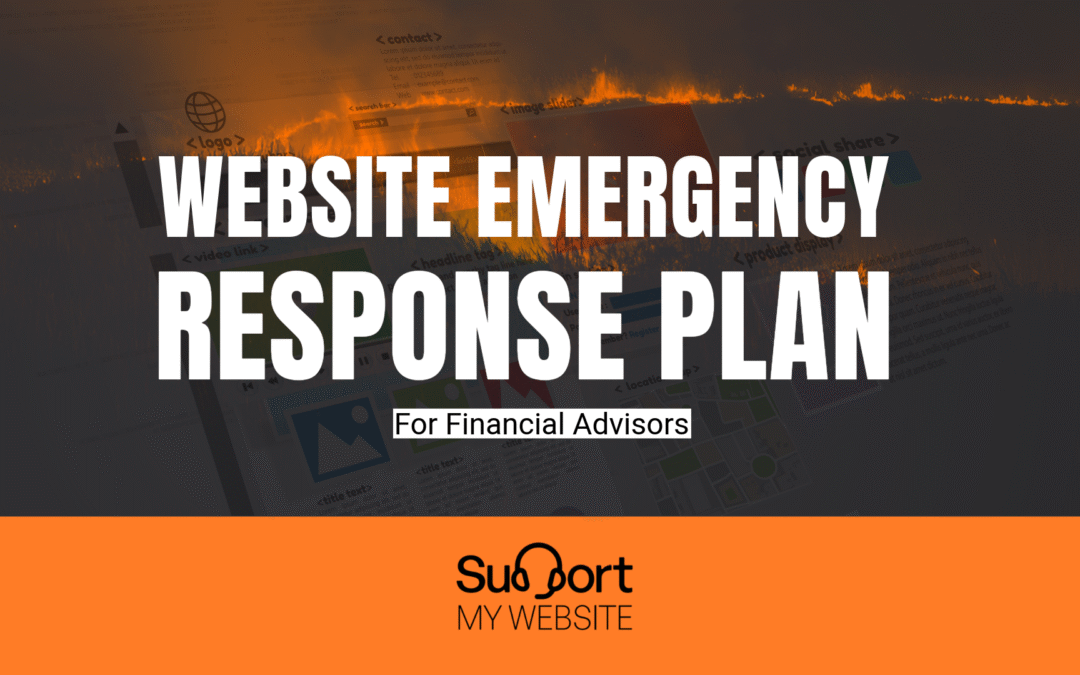When Websites Fail, Clients Notice
If your site fails clients notice and sometimes so do regulators. Reliability is inseparable from trust in our industry. If you think website emergencies only happen to “other” firms, let’s just say: Equifax, the CIA, and Sony all thought the same thing, until they hit the headlines for all the wrong reasons. The stakes? Lost credibility, angry clients, and sometimes, regulatory action with real teeth (see the SEC’s guidance on cyber incidents).
Here’s the plan: I’ll lay out a battle-tested emergency framework, peppered with real stories (and a few scars). You’ll get scripts, checklists, and templates used in live-fire situations. By the end, you’ll know how to protect your brand and your clients when—not if—the internet gods decide to mess with your uptime.
As usual, my disclaimer: I am not an attorney and I am certainly not your attorney. These are just examples of what you might do, but as always, get your attorney and compliance officer to review this stuff before you implement anything. Also, there areas that require additional messaging not included in this document. In other words, this is a good start, but it is just a start.
Understanding Website Emergencies in Financial Services
If you’re a financial advisor, planner, or fintech operator, your website is a high-value target for hackers, compliance auditors, and the occasional overzealous plugin update. The emergencies come in three flavors: security, performance, and compliance.
Security Breach Scenarios
Real Example:
One client called after seeing weird pop-ups for “investment opportunities” on their homepage (spoiler: not the kind you want). Turns out, a plugin vulnerability let malware slip in. Fast forward: regulators got involved, and we spent weeks cleaning up. This isn’t rare—financial services are the top target for cyberattacks.
- Data compromise detection:
Watch for unusual logins, password resets, or data exfiltration. If you wait for a client to report it, you’re already behind (Verizon 2023 Data Breach Investigations Report). - Malware infection discovery:
Automated malware scanning is crucial, but so is manual vigilance. Malicious code can lurk undetected for weeks (Symantec Internet Security Threat Report). - Unauthorized access attempts:
Failed logins, new admin accounts, or unexplained file changes? Treat them like someone jiggling your office door at midnight (FBI Cybercrime Statistics).
Performance Crisis Situations
- Complete website downtime:
Could be a hosting failure, expired SSL, or a DDoS attack. Every minute down erodes client trust (Gartner estimates downtime costs can exceed $5,600 per minute). - Severe performance degradation:
Slow sites frustrate clients and may violate SLAs (Google research shows 53% of mobile users abandon sites that take over 3 seconds to load). - Mobile accessibility failures:
If half your clients can’t access their accounts on mobile during peak volatility, expect an angry mob (Statista: Mobile accounts for over 50% of global web traffic).
Compliance Emergency Events
- Regulatory violation discovery:
An update wipes out your ADV Part 2 or privacy notice. You’re out of compliance and exposed to fines (SEC’s Regulation S-P). - Content accuracy failures and disclosure omissions:
Outdated rates, missing disclosures, or broken calculators are more than embarrassing—they’re a compliance risk (FINRA’s guidance on communications with the public).
High-Impact Timing Considerations
Emergencies always sting, but some moments are worse:
If your site fails when clients need it most, the damage multiplies.
The 4-Hour Emergency Response Protocol
When the site’s down and the phone’s ringing off the hook, you have four hours before chaos becomes catastrophe. Here’s my playbook—adapted from real incidents and best-practices (NIST Computer Security Incident Handling Guide; SANS Incident Handler’s Handbook).
Hour 1: Assessment and Containment
1. Initial Problem Identification (15 Minutes)
- Is the whole site down, or just a section?
- Can you access the admin backend?
- Any security warnings?
- Use external tools like Down for Everyone or Just Me to verify.
2. Impact Assessment Framework (20 Minutes – 1h)
- Who’s affected? (Clients, staff, vendors)
- Is client data at risk?
- Is this a compliance issue?
- What’s the worst-case scenario?
3. Immediate Containment Measures (25 Minutes)
- Take the site offline if a breach is suspected.
- Deploy a maintenance notice (template below).
- Change all admin credentials.
- Check backups—do NOT proceed if you can’t restore (NIST SP 800-61r2).
Hour 2: Stakeholder Communication
1. Internal Team Notification Protocols
- Alert management, compliance, and IT.
- Assign a communication lead.
- Begin documenting every action (SANS Incident Handler’s Handbook).
2. Client Communication Strategies
- Use pre-approved scripts:
“We’re experiencing a technical issue affecting our website. Your data remains secure. We’ll update you regularly.”
- Update voicemail and email auto-replies.
- Call top clients directly if needed.
3. Regulatory Notification Requirements
- If a breach is confirmed or likely, review reporting requirements for SEC, FINRA, or state authorities (SEC Cybersecurity Disclosure Guidance).
Hour 3: Technical Response Implementation
1. Emergency Maintenance Provider Activation
- Contact your emergency web support.
- If you don’t have a support provider, you need one immediately.
2. Backup System Deployment
- Activate backup hosting if available.
- Redirect DNS as needed (Cloudflare: How to change your DNS).
3. Security Incident Response
- Run malware scans and forensic tools.
- Isolate infected systems.
- Preserve all logs and evidence (NIST SP 800-61r2).
Hour 4: Recovery and Documentation
1. Primary System Restoration
- Restore the cleanest recent backup (Backup best practices: CSO Online).
- Test all critical functions.
2. Functionality Verification
- Ensure client portals, calculators, and all disclosures are present.
- Test both desktop and mobile.
3. Incident Documentation Requirements
- Record every action, timestamp, and communication.
- Retain logs and evidence for compliance (NIST SP 800-61r2).
Emergency Communication Templates
Here are practical scripts adapted from industry best practices (SANS Incident Handler’s Handbook; SEC Guidance).
Internal Stakeholder Communications
Partner/Management Notification
Subject: URGENT: Website Emergency – Immediate Action Required
Team:
Our website is experiencing [describe issue]. Actions taken: [list].
Next update in 30 minutes.
All client inquiries to [name].[Your Name]
Staff Protocol
Subject: Website Outage – Client Protocol
Tell clients:
“We’re aware of the issue and working to resolve it. Data is secure. We’ll keep you updated.”No speculation. Refer all questions to [name].
Vendor Coordination
“We have a website emergency. Please prioritize and update every 30 minutes.”
Client Communication Framework
Website Downtime Notification
Subject: Website Temporarily Unavailable
Our website is offline due to technical issues. Data is secure. Updates every hour. For urgent matters, call [number].
Security Incident Disclosure
Subject: Important Security Update
We’ve identified a security issue. Your data security is our top priority. Investigation ongoing. Contact us for concerns.
Service Restoration Update
Subject: Website Restored
All services are back online. Thank you for your patience. Please report any issues.
Regulatory Communications
SEC Notification
“Reporting a website technical incident. Data exposure [confirmed/not confirmed]. Full report within [required timeframe].”
State Reporting
“Website incident affecting [number] clients. Following protocol. Full report by [date].”
Industry Alerts
“Experienced a website outage/security event on [date]. Following all required protocols.”
Technical Emergency Response Procedures
Backup System Activation
- Deploy backup hosting.
- Update DNS records (Cloudflare DNS guide).
- Prioritize client portal and disclosures.
Security Incident Response
- Take system offline.
- Preserve forensic evidence (logs, backups).
- Notify law enforcement if needed (FBI Cybercrime Reporting).
Data Recovery Protocols
- Test backups before restoring (CSO Online: Backup best practices).
- Verify data integrity.
- Require password resets for affected clients.
Business Continuity Measures
- Use alternative communication (phone, email).
- Activate manual processes for critical services.
- Assign staff to client calls.
Post-Emergency Analysis and Improvement
Root Cause Analysis
- What failed? (Tech, process, human error)
- Was it preventable?
- What needs monitoring going forward?
Stakeholder Debrief
- Internal review: what worked, what didn’t.
- Collect client feedback.
- Evaluate vendor performance.
Emergency Plan Updates
- Update documentation and contacts.
- Schedule training and drills.
- Incorporate lessons learned.
Rapid-Fire Takeaways
- Website emergencies WILL happen—plan for them.
- Assess, contain, communicate, recover—document everything.
- Use and update templates/checklists regularly.
- Debrief and strengthen your plan after every incident.
- Don’t wait—practice your response now.
Action Steps
- Download and customize your templates today (see SANS and NIST links above).
- Schedule a fire drill with your team next week.
Stay sharp, stay safe, and don’t let a website outage define your client experience.

Jason Long
Jason is a serial problem solver and entrepreneur with 20+ years of experience in business building.
Jason’s ventures range from agriculture to healthcare with a focus on web-based technology. He has extensive experience in software development and has operated as a developer, UX designer, graphic designer, project manager, director, executive coach, and CEO.
Linkedin
Personal Website
References / Further Reading
- S&P 500 Market Halt, CNBC, March 2020
- Equifax Breach, Reuters
- Sony Hack, Wired
- CIA Hacking Tools Leak, NYT
- IBM Cost of Data Breach Report
- Verizon Data Breach Investigations Report
- Symantec Internet Security Threat Report
- FBI Cybercrime
- Gartner Cost of Downtime
- Google Mobile Speed Benchmarks
- Statista Mobile Web Traffic
- SEC Cybersecurity Guidance
- SEC Regulation S-P
- FINRA Rule 2210
- IRS Filing Season Statistics
- Federal Reserve News
- NIST Incident Handling Guide
- SANS Incident Handler’s Handbook
- Cloudflare DNS Guide
- CSO Online: Backup Best Practices
- FBI Cybercrime Reporting (IC3)
